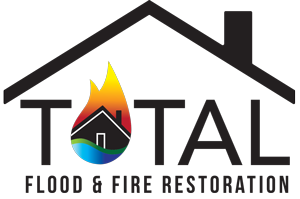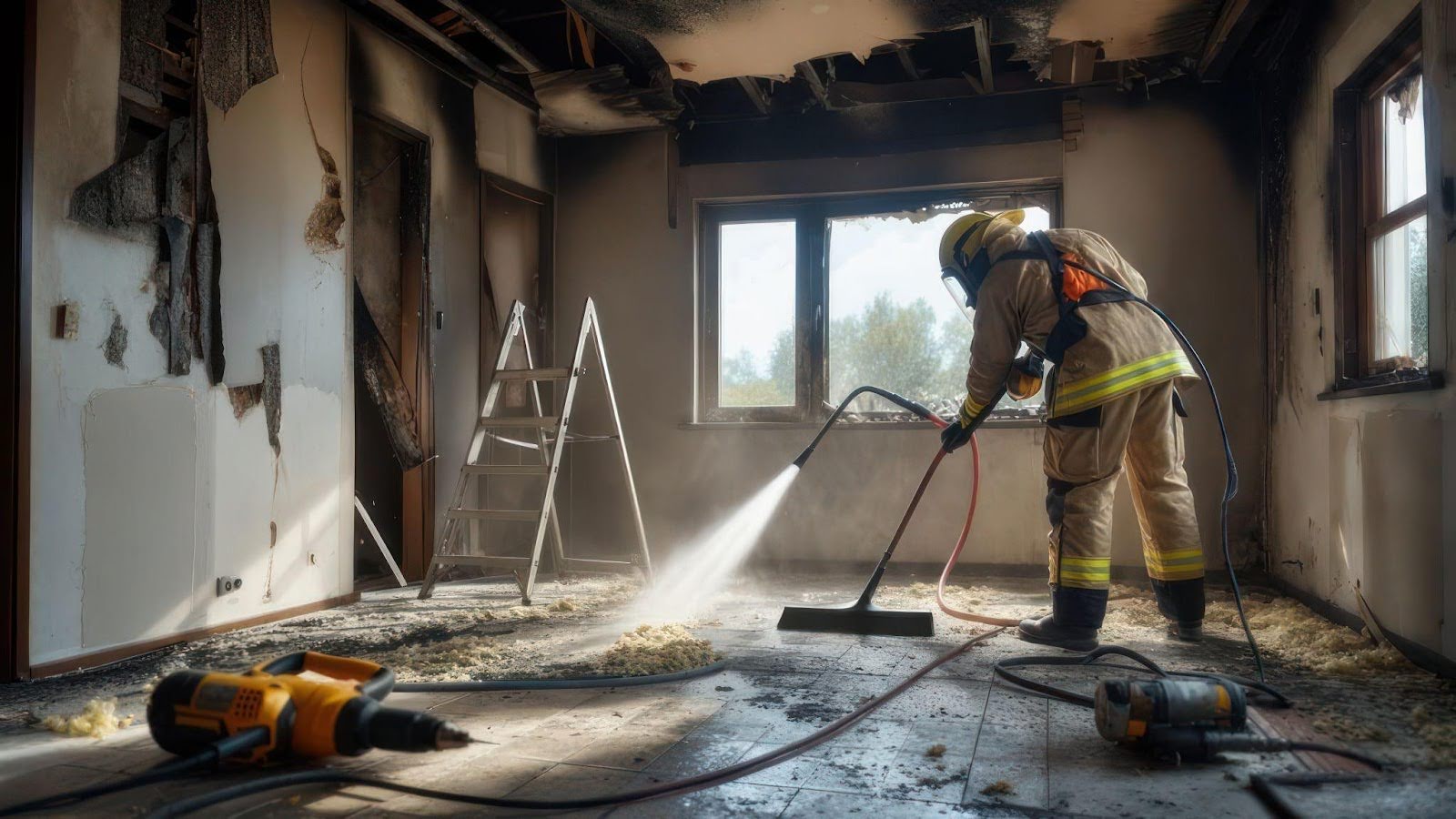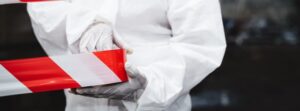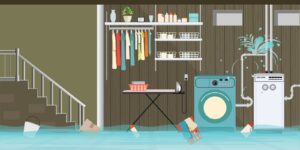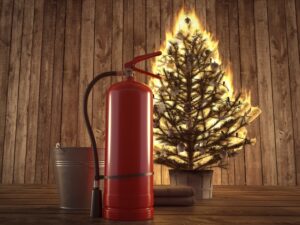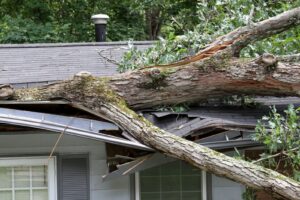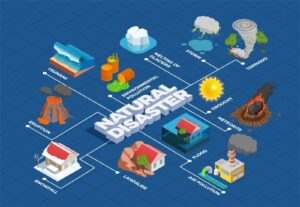After a fire sweeps through a home or business, the damage it leaves behind goes far beyond what you can see. Scorched walls, charred furniture, and destroyed belongings only tell part of the story. Hidden in the air and on surfaces, fire residue continues to affect the safety of your indoor environment long after the flames go out.
This blog helps homeowners, landlords, and property managers understand how fire residue impacts indoor air quality. It also offers practical guidance on why and how to eliminate these harmful particles. With expert insight and actionable tips, you’ll know what steps to take to restore your space and protect the health of everyone who lives or works there.
What is fire residue?
After a fire, the visible damage tells only part of the story. The air and surfaces inside your home or building often carry lingering contaminants known as fire residue. This hazardous mix includes soot, ash, smoke particles, and chemical byproducts released from burned materials.
Fire residue can spread quickly through the air, settle on furniture, and enter your HVAC system, quietly compromising the safety of your indoor environment.
Different types of fire residue
The type of residue that remains after a fire depends largely on what materials burned. Each one produces distinct particles with varying levels of toxicity and cleanup difficulty:
- Wood and paper release dry, powdery ash and light soot that spreads easily but can be wiped clean with care.
- Plastics and synthetic materials create greasy, sticky soot that clings to surfaces and releases harmful chemicals.
- Protein-based fires (such as kitchen fires) leave behind a nearly invisible, foul-smelling residue that seeps into walls and fabric.
- Electrical fires, especially those involving chemical compounds, generate toxic fumes and fine particulate matter that coat your home in a dangerous film.
Each substance carries unique health and environmental risks, especially when inhaled or absorbed through skin contact.
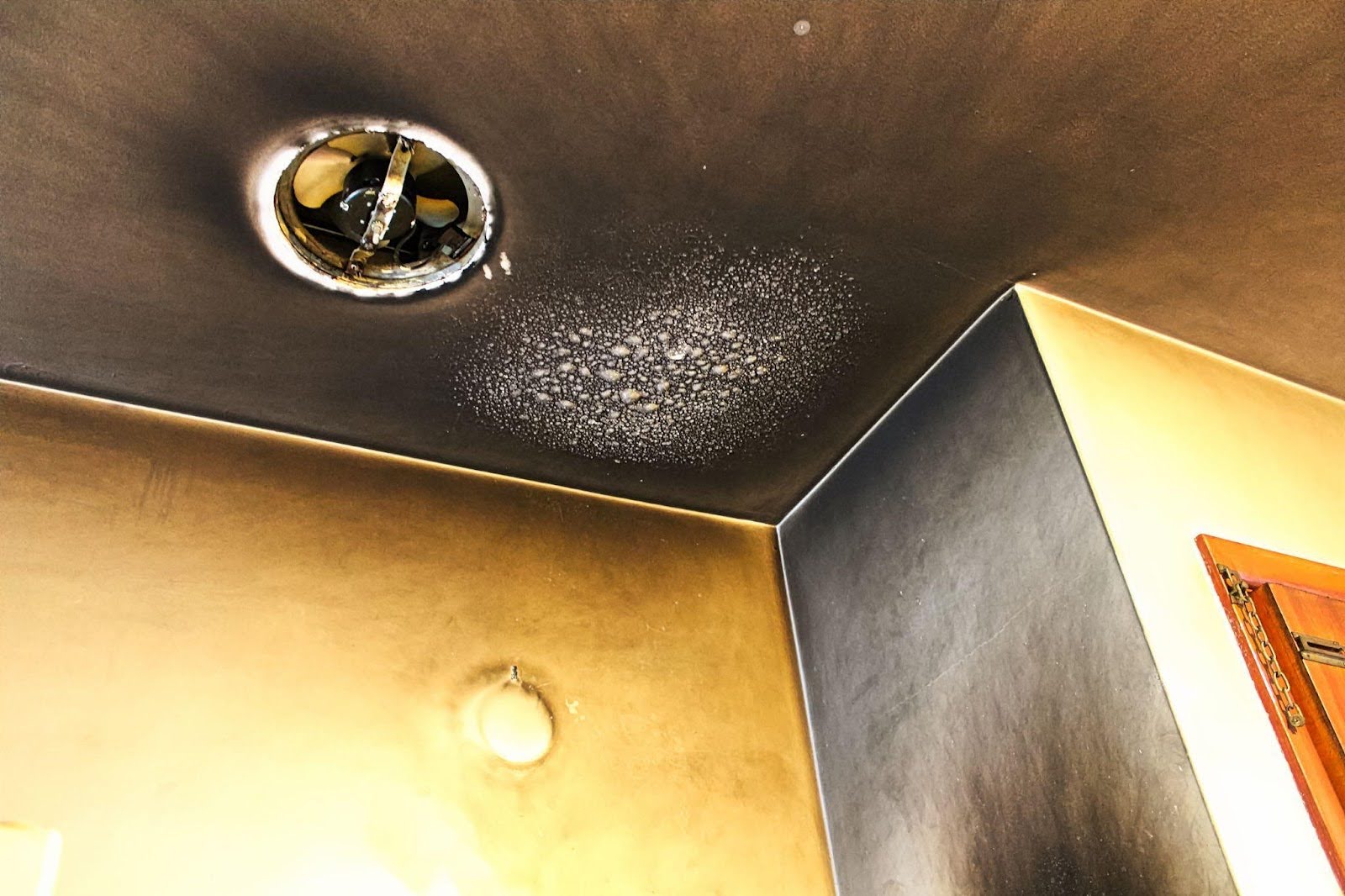
How fire residue spreads and lingers
Fire residue travels through the air during and after the fire event. Microscopic particles remain suspended long after visible smoke clears. These particles infiltrate ductwork, carpets, upholstery, insulation, and drywall, making complete removal challenging without professional help.
Your heating or cooling system continues circulating these pollutants if not properly cleaned, exposing occupants to prolonged risk.
Fire residue can contaminate the entire building even when the fire affects only one part of a property. It seeps into porous materials and clings to ceilings, walls, and electronics, contributing to poor indoor air quality and long-term health hazards if left untreated.
How fire residue affects indoor air quality
Fire residue seriously threatens indoor air quality long after flames have been extinguished. These microscopic particles and chemical byproducts contaminate the air, surfaces, and ventilation systems in ways that are often invisible but extremely harmful.
Immediate air contamination from harmful particles
When a fire burns through materials like wood, plastics, paint, and fabric, it releases a cocktail of toxic pollutants into the air. These include:
Carbon monoxide
Carbon monoxide is a colorless, odorless gas that disrupts oxygen flow in the body and, at high levels, can cause headaches, dizziness, and even unconsciousness.
Volatile Organic Compounds (VOCs)
VOCs are gases released from burned synthetic materials that irritate the eyes, throat, and lungs. Long-term exposure increases the risk of cancer and respiratory illness.
Fine soot particles
These microscopic solids travel deep into the lungs, causing breathing difficulties, aggravating asthma, and potentially entering the bloodstream.
Even after the smoke clears, these pollutants linger and continue to circulate through the home’s air supply.
Long-term toxins embedded in your home
Fire residue does not stay airborne forever. It settles into soft surfaces like carpets, upholstery, and curtains, and penetrates porous materials, including drywall, insulation, and wood.
HVAC systems also collect and distribute residue throughout your home if filters and ductwork remain uncleaned. These hidden toxins contribute to chronic poor air quality and increase the risk of long-term health issues.
Residue embedded in your home’s structure does not degrade easily. It continues to release particles and fumes over time, particularly when humidity, temperature changes, or air circulation disturb the contaminated areas.
Risk of recontamination without professional cleanup
Without thorough decontamination, fire residue becomes a recurring problem. Vacuuming, dusting, or running the HVAC system can release embedded particles back into the air. This creates a cycle of recontamination that undermines your recovery efforts and exposes occupants to continued risk.
Only trained professionals with specialized equipment can remove embedded soot, eliminate lingering toxins, and restore safe indoor air quality. Understanding these risks underscores the importance of a full environmental cleanup after any fire, no matter how small.
Health risks associated with poor indoor air after a fire
After a fire, the threat doesn’t end with visible damage. Harmful particles and chemical compounds left behind in the air can create ongoing health hazards, especially when cleanup is delayed or incomplete. Fire residue affects everyone, but some individuals face far greater risks from prolonged exposure.
Respiratory problems from inhaled pollutants
Soot, ash, and toxic gases irritate the lungs and airways. When exposed to these airborne pollutants, people often experience coughing, wheezing, and shortness of breath.
Post-fire air quality can worsen symptoms significantly and trigger severe respiratory episodes for individuals with asthma, bronchitis, or allergies. Even healthy individuals may develop throat irritation or breathing discomfort after extended exposure.
Neurological effects from toxic fumes
Certain chemical byproducts, such as carbon monoxide and VOCs, interfere with the brain’s oxygen supply. Prolonged exposure to these substances may cause headaches, dizziness, nausea, and fatigue. In more serious cases, neurotoxins like formaldehyde and acrolein can impair cognitive function and contribute to long-term nervous system disorders.
Heightened vulnerability for sensitive groups
Children, older adults, and people with compromised immune systems face the most severe effects of post-fire air contamination. Their bodies cannot process or eliminate toxins as efficiently, which increases the risk of infections and chronic illness. Infants and toddlers, in particular, breathe more rapidly and spend more time on the floor, where residue often settles.
Increased cancer risk from carcinogenic residue
Many fires release carcinogenic compounds into the air, especially when plastics, paints, or treated wood burn. Substances such as benzene, dioxins, and formaldehyde linger in carpets, drywall, and air ducts. Continued exposure, even at low levels, raises the risk of certain cancers over time.
Without professional remediation, these toxins continue to pollute the air and harm occupants long after the fire is out.
Addressing indoor air quality after a fire protects your immediate and long-term health. Prompt cleanup and air purification reduce these risks and restore a safe, breathable environment for everyone in your home or building.
Professional fire cleanup vs. DIY: Why expert help matters
Cleaning up after a fire may seem like a task you can handle with basic tools and determination, but DIY efforts rarely deliver safe, lasting results. Fire residue hides in places that surface cleaning overlooks. Without expert help, you risk worsening the damage and breathing harmful particles.
DIY methods fail to remove hidden contaminants
Scrubbing walls or vacuuming floors only removes what’s visible. Microscopic soot particles remain suspended in the air and settle deep into carpets, upholstery, insulation, and air ducts. These particles release toxic compounds long after the initial cleanup, harming your indoor environment even when everything appears clean.
Improper handling worsens air quality
Untrained attempts to clean soot often disturb the particles, pushing more into the air. Sweeping or dry-dusting fire residue spreads contamination rather than containing it. Each motion sends toxins into your breathing space, increasing the risk of respiratory issues and prolonged exposure.
Lack of professional-grade tools compromises safety
Effective cleanup demands more than a mop and bucket. Professionals rely on HEPA air scrubbers, ozone machines, and personal protective equipment to safely contain and remove toxins. Most homeowners cannot access this equipment, and using the wrong tools may leave harmful residue behind or damage surfaces further.
How professionals restore indoor air quality
Certified fire restoration teams follow proven steps to eliminate residue and restore safe air. Their approach combines deep cleaning with advanced filtration and safety checks.
Ventilate the space and assess damage
Ventilation comes first. Professionals open windows and doors to improve airflow and reduce immediate smoke exposure. They inspect the structure before entering affected rooms to ensure safety.
Remove porous materials and clean surfaces
Technicians discard damaged materials that absorb soot and smoke, such as carpets, drywall, and insulation. They scrub hard surfaces using products formulated to neutralize fire residue and prevent lingering odors.
Use advanced air filtration
HEPA filters and activated carbon purifiers run continuously to remove microscopic particles and neutralize airborne chemicals. These tools restore breathable air and prevent recontamination.
Clean HVAC systems and ducts
Smoke travels through vents and settles deep within ductwork. Professional teams clean and sanitize the HVAC system to stop the cycle of recirculating toxins throughout the home.
Test air quality before reoccupation
Before declaring a space safe, experts test for carbon monoxide, VOCs, and fine particulate matter. These tests confirm the air is clean and ensure the space supports a healthy recovery.
Protect your health and home with Total Flood and Fire’s expert help
Total Flood and Fire Restoration provides expert fire residue removal backed by industry certifications, advanced tools, and years of experience. Whether you need immediate help or a full restoration plan, Total Flood and Fire responds with speed, compassion, and precision.
Don’t risk your family’s safety with surface-level solutions. Trust our team to eliminate fire residue at the source and restore your home to a clean, healthy environment. Contact Total Flood and Fire Restoration today for an assessment or emergency service.
